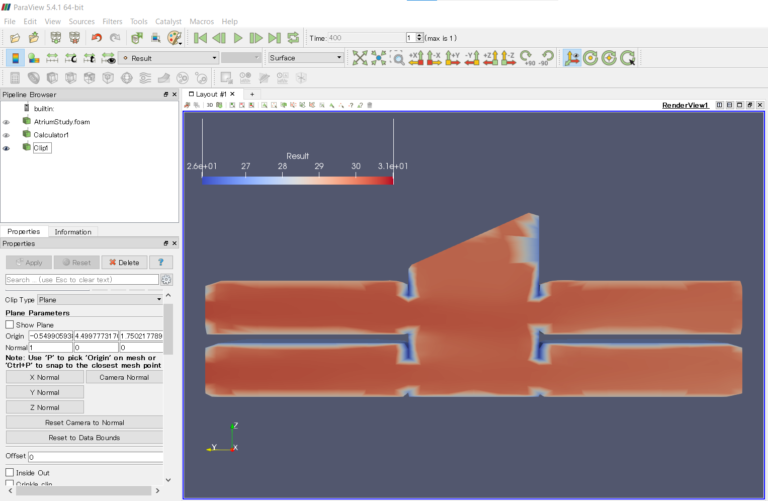

I hope you don’t intend to do processing for each time step in ParaView. 40-60 million gridpoints and 5 calculated values at each for a couple million timesteps Or if you don’t need to use OptiX, you could also use an AMD GPU. So you could save some money here by getting a lower-tier GPU with enough VRAM. For meshes with 50 million cells, 16GB of VRAM should be plenty. Additionally, the GPU memory determines how big of a model you can have visible. And if you are using ray tracing with OptiX, an Nvidia GPU will handle that. It helps with 2 things: how fluid it is to interact with the model. The GPU has little/no influence on how fast the data and filters are processed.

I would appreciate any input!įor reference, the system I have chosen is: Ryzen 9 7950x3d, RTX 4090, 128gb 5200 mhz ddr5 ram. I am trying to decide if it is worth it to instead go for a server CPU with more cores but slower clock speeds (about 2.5 ghz instead of 4.5 base) and more RAM, get an A6000 instead of a 4090, or if the components I have chosen will do the job just fine. And, when using a GPU, paraview primarily uses the CPU to load each timestep and original model while the GPU does the heavy lifting of rendering.Īs such, I have tentatively chosen the Ryzen 9 7950x3d for the CPU and RTX 4090 for the GPU. From what I understand, ParaView utilizes all CPU threads when available, but can use GPU. These cases are rather large (~40-60 million gridpoints and 5 calculated values at each for a couple million timesteps). I primarily use ParaView to visualize OpenFOAM cases (reconstructed) that have been run on a remote cluster. The quick tip format seems to be quite popular, but if I’m wrong, let me know.Hello, I am putting together components for a workstation and I am at a crossroads on a couple of decisions. There you go, a quick ParaView tip that might come in useful one day. You can easily strip them out to make it compatible, just don’t do it to a live/running data file – you’ll really confuse things. There’s one gotcha: it doesn’t work with vector data.įor example, if you’re monitoring a vector field or force/moment components, then the reader will trip over the parentheses in the data file 🙈 If you’re monitoring a live run, then right-click the data in the pipeline browser & click Reload Files to re-read the data (the settings for the chart & reader are sticky – they don’t reset when you do this). If you want to ignore the start of the file, then just increase the number of header lines in the reader & it’ll skip that many lines. You can pan & zoom around using the mouse (just like you would in 2D mode) & reset the zoom using the usual buttons.
Openfoam paraview series#
You can customise things to your hearts content – add legends and titles, turn series on/off, mess with fonts & colours etc. Change the default spreadsheet view to a line chart view, make sure the data is visible (click the eye in the pipeline browser) & you should have yourself a line chart. number of records at 0 will read in the whole data file.Ĭlick Apply & that should do it. we need to skip 1 leading # to get the column names right.our column names are on line 4 (note that it’s 0 indexed).5 lines in our header (those starting with # ).In this case (see sample of the data file above), we have: If you open that file directly in ParaView it won’t quite know what to do with it & ask you to choose your preferred reader:Ĭhoose Tecplot Table Reader, click OK & then we’ll need to give it some info about our input file. $FOAM_CASE/postProcessing/patchAverage/0/surfaceFieldValue.datįilled with our lovely tabulated data, looking something like this: Let’s take the output of a pressure monitor made using patchAverage via surfaceFieldValue as our example. You could do the same thing in gnuplot – but it’s nice to have options, especially if they don’t require Googling the (gnuplot) commands that I forgot, again. I usually use it on remote machines, where I’ll bring up a client-server ParaView & have a quick check – most definitely not watching convergence, no way, not me. The kind of info that’s handy to take a quick peak at while a simulation is running or as a visual convergence check after the fact. I’m talking about plotting the output from functionObjects like forceCoeffs or surfaceFieldValue – i.e. You can read OpenFOAM monitor (.dat) files directly into ParaView using the Tecplot Table reader 🤫 It’s particularly useful on remote machines &/or if you’re allergic to gnuplot. Something that might come in handy for a quick job check or for monitoring convergence. It’s Robin from CFD Engine & I’m back with a super-specific little ParaView tip.


 0 kommentar(er)
0 kommentar(er)
